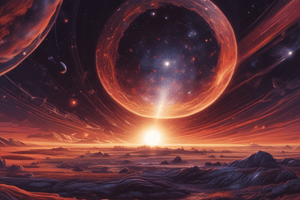Podcast
Questions and Answers
What is the definition of a black hole?
What is the definition of a black hole?
- A region in space where the gravitational pull is zero
- A region in space where the gravitational pull is equal to the speed of light
- A region in space where the gravitational pull is weak
- A region in space where the gravitational pull is so strong that nothing, including light, can escape (correct)
What is the point of no return around a black hole?
What is the point of no return around a black hole?
- Event Horizon (correct)
- Singularity
- Ergosphere
- Gravitational Lensing
What is the center of a black hole characterized by?
What is the center of a black hole characterized by?
- Infinite density and zero gravity
- Infinite density and gravity (correct)
- Infinite gravity and zero density
- Zero density and gravity
What type of black hole is formed from the collapse of individual stars?
What type of black hole is formed from the collapse of individual stars?
What is the region around a rotating black hole where the gravity is so strong that it can pull objects inward?
What is the region around a rotating black hole where the gravity is so strong that it can pull objects inward?
What is the bending of light around a black hole due to its strong gravity?
What is the bending of light around a black hole due to its strong gravity?
What is the rotation of space-time around a rotating black hole?
What is the rotation of space-time around a rotating black hole?
What happens to objects that get too close to a black hole?
What happens to objects that get too close to a black hole?
How do telescopes detect black holes?
How do telescopes detect black holes?
What is detected by the merger of two black holes or a black hole and a neutron star?
What is detected by the merger of two black holes or a black hole and a neutron star?
Flashcards are hidden until you start studying
Study Notes
Black Holes
Definition
- A region in space where the gravitational pull is so strong that nothing, including light, can escape
- Formed when a massive star collapses in on itself and its gravity collapses in on itself
Characteristics
- Event Horizon: The point of no return around a black hole; any matter or energy that crosses the event horizon is trapped
- Singularity: The point at the center of a black hole where the density and gravity are infinite
- Ergosphere: The region around a rotating black hole where the gravity is so strong that it can pull objects inward
Types of Black Holes
- Stellar Black Holes: Formed from the collapse of individual stars
- Supermassive Black Holes: Found at the centers of galaxies, with masses millions or even billions of times that of the sun
- Intermediate-Mass Black Holes: Black holes with masses that fall between those of stellar and supermassive black holes
Effects on Light and Matter
- Gravitational Lensing: The bending of light around a black hole, causing it to follow the curvature of space-time
- Frame-Dragging: The rotation of space-time around a rotating black hole, causing any nearby matter to move along with it
- Spaghettification: The stretching and eventual breakage of objects that get too close to a black hole due to intense gravitational forces
Detection and Study
- X-rays and Gamma Rays: Telescopes can detect X-rays and gamma rays emitted by hot gas swirling around black holes
- Radio Waves: Radio telescopes can detect radio waves emitted by matter as it spirals into a black hole
- Gravitational Waves: The detection of ripples in space-time produced by the merger of two black holes or a black hole and a neutron star
Definition and Formation of Black Holes
- A black hole is a region in space where gravity is so strong that nothing, including light, can escape
- Formed when a massive star collapses in on itself and its gravity collapses in on itself
Characteristics of Black Holes
- Event Horizon: the point of no return around a black hole, where any matter or energy that crosses it is trapped
- Singularity: the point at the center of a black hole where density and gravity are infinite
- Ergosphere: the region around a rotating black hole where gravity is so strong that it can pull objects inward
Types of Black Holes
- Stellar Black Holes: formed from the collapse of individual stars
- Supermassive Black Holes: found at the centers of galaxies, with masses millions or even billions of times that of the sun
- Intermediate-Mass Black Holes: black holes with masses that fall between those of stellar and supermassive black holes
Effects of Black Holes on Light and Matter
- Gravitational Lensing: the bending of light around a black hole, causing it to follow the curvature of space-time
- Frame-Dragging: the rotation of space-time around a rotating black hole, causing any nearby matter to move along with it
- Spaghettification: the stretching and eventual breakage of objects that get too close to a black hole due to intense gravitational forces
Detection and Study of Black Holes
- X-rays and Gamma Rays: telescopes can detect X-rays and gamma rays emitted by hot gas swirling around black holes
- Radio Waves: radio telescopes can detect radio waves emitted by matter as it spirals into a black hole
- Gravitational Waves: the detection of ripples in space-time produced by the merger of two black holes or a black hole and a neutron star
Studying That Suits You
Use AI to generate personalized quizzes and flashcards to suit your learning preferences.




